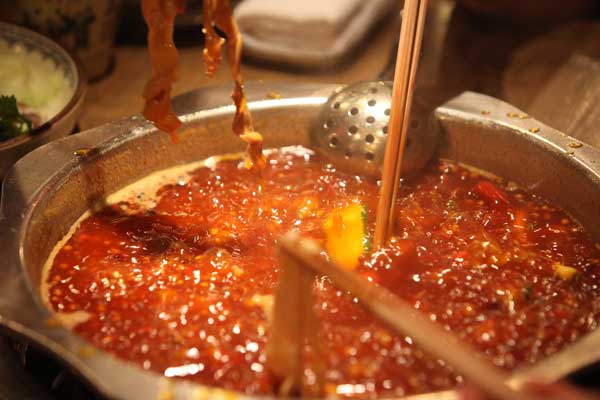| Crazy about hotpot | |||
http://english.dbw.cn
2014-02-07 08:54:48
|
|||
|
It's a cuisine popular all over China, but Chongqing businessman Nie Ganru loves hotpot more than most. He tells Luo Wangshu and Tan Yingzi why he wants to tell the world about his favorite meal. When Prime Minister of the United Kingdom David Cameron visited China in December, in among the appointments on his busy schedule was one that was in stark contrast to the politician's serious meetings and briefings: "Eat spicy hotpot". Cameron is not the only world leader with a taste for the popular cuisine. United States politician Henry Kissinger wrote about eating hotpot with the former Chinese leader Deng Xiaoping in his memoirs. Kuomintang leader Chiang Kai-shek treated Mao Zedong to spicy hotpot during his historic visit to Chongqing in 1945. Now all these hotpot stories have been collated and displayed in a museum dedicated to hotpot cuisine. Located in Chongqing, it is the first hotpot museum in the country. Hotpot is popular in Chongqing. While the soup is simmering over a flame, meat and vegetables are placed into the pot to cook, and diners can pick out the items when they are ready to eat. Chongqing hotpot is famous for its spicy taste. The hotpot museum, with more than 600 pots and other items on display, opened in December, 2013. A 37-meter-tall hotpot graces the exterior of the six-story private museum, located in the city's southeast. On its first floor, the large hotpot-shaped building features modern hotpots, an explanation of what a hotpot is, and displays examples of pots from all over the world, including a paper-pot from Japan and an iron pot from Germany. The second floor covers the Chongqing hotpot and related art works. It also documents the origins of spicy hotpot. This floor also demonstrates how the spicy hotpot went from being street food to a nationally celebrated dish during the War of Resistance against Japanese Aggression (1937-45). The third floor exhibits valuable pots and also highlights the history of hotpot, with particular emphasis on Chinese hotpot culture. The most prized collections are located on this floor, including a pot used in the Qing Dynasty (1644-1911), when Emperor Qianlong hosted a banquet for 1,000 elderly people, and a tri-colored glazed pot of the Tang Dynasty (AD 618-907). The fourth and fifth floors are yet to open, but there are plans to open a high-end hotpot restaurant there. Nie Ganru, 70, a hotpot fan and businessman, is the owner of the museum. The energetic man has a passion for hotpot and has collected pots for more than 30 years. "Every pot has a story," he says. One of his most prized items is the tri-colored glazed pot of the Tang Dynasty, worth about 1.8 million yuan ($300,000). He bought it in Chengdu in 1998 for only 180 yuan. "I was very lucky on that one," he recalls. "Some of my collection was easily acquired, I was sometimes lucky to find things on the street. And some were only acquired with much time and money. I flew all over the country for some pots, negotiating with the sellers to persuade them to sell the pot to me," he says, adding that whenever he travels to a new city, he will go to the grocery store to study pots. |
|||
| Author: Source: xinhua Editor: Yang Fan |
|||
 中文简体
中文简体











